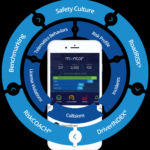Blog
Waking Up to Safety: Fighting Fatigue While Driving for Work Purposes!
Originally published in Fleet Management Weekly 09/08/23

By Ed Dubens, CEO/Founder of eDriving
In today’s bustling world, where work obligations often collide with the demands of the road, addressing driver fatigue has never been more critical. The safety of employees driving for work purposes is a matter of paramount importance. Driver’s Managers, as well as Environment, Health, Safety and Sustainability (EHS&S), and Risk Managers are uniquely positioned to lead the charge in mitigating the impact of fatigue and ensuring our roads are safer for all.
Far too often, drivers disregard the signs of fatigue, forging ahead despite the telltale signs of drowsiness. Yawns and missing exits off the highway are often dismissed as a mere inconvenience! However, it is imperative to recognize that a yawn is not merely a reflex; it’s a warning. Driving while fatigued can be as hazardous as driving under the influence of alcohol, a truth we cannot ignore.
Guiding the Way: Employer Responsibilities and Duty
Employers, under global health and safety regulations, bear a significant duty of care to manage the risks of fatigue among employees who drive for work. Effective management necessitates the establishment of a Fatigue Risk Management Program. This program should encompass measurement, monitoring, and the active management of fatigue-related risks, coupled with clear and open communication with employees regarding the perils of fatigued driving.
 A comprehensive fatigue risk management program covers a range of aspects, from setting limits for driver hours and requiring rest breaks, to fostering a culture that encourages discussions about fatigue-related concerns and challenges. Research highlights the hidden costs of fatigue for employers, emphasizing the financial toll resulting from diminished productivity, absenteeism, and healthcare costs incurred due to exhausted employees.
A comprehensive fatigue risk management program covers a range of aspects, from setting limits for driver hours and requiring rest breaks, to fostering a culture that encourages discussions about fatigue-related concerns and challenges. Research highlights the hidden costs of fatigue for employers, emphasizing the financial toll resulting from diminished productivity, absenteeism, and healthcare costs incurred due to exhausted employees.
Empowering Drivers through Education
Education serves as an effective tool in enhancing driver safety. New recruits benefit from comprehensive education about fatigue-related risks, while all employees gain from periodic refresher training. Drivers at elevated risk can derive immense value from personalized coaching. Regular updates from management on the latest research and best practices regarding driver fatigue empower employees to make informed decisions.
It’s vital for drivers to grasp the factors influencing sleep quality (lifestyle, including diet and exercise, medical issues and/or medications, shift hours, stress, family responsibilities, etc.), the ramifications of sleep deprivation, and strategies for maintaining proper sleep hygiene. Equipping them with knowledge about ensuring sufficient rest and actions to take when fatigued can significantly bolster road safety.
A Supportive Culture for Fatigue Management
Too often, employees grappling with fatigue-related issues, such as sleep disorders, hesitate to approach their managers due to job security concerns. This hesitancy can imperil road safety. An employee-friendly policy requires managers to encourage such employees to seek medical consultation and to temporarily relieve them of driving duties until treatment is received.
Smart Scheduling and Route Planning
 Deliberate trip scheduling plays a pivotal role in fatigue prevention. Trips should be planned to avoid driving between 2 a.m. and 6 a.m., a period associated with increased fatigue. Acknowledging the biological dip in alertness during the afternoon is also crucial. If driving during these potentially risky times is unavoidable, drivers must have sufficient rest beforehand.
Deliberate trip scheduling plays a pivotal role in fatigue prevention. Trips should be planned to avoid driving between 2 a.m. and 6 a.m., a period associated with increased fatigue. Acknowledging the biological dip in alertness during the afternoon is also crucial. If driving during these potentially risky times is unavoidable, drivers must have sufficient rest beforehand.
Flexibility in scheduling, considering unforeseen delays, and granting employees the freedom to take planned breaks regardless of time constraints are critical strategies. Managers should also account for employees’ commute times when planning daily schedules.
Continuous Monitoring and Care
Ongoing monitoring assists managers in tracking fatigue risk factors. Telematics data offers insights into driver performance and potential concerns. Asking pertinent questions about driving hours, shifts, sleep opportunities, and personal life changes can help build a comprehensive profile of each driver.
Managers, even those working in an office, can be attuned to outward, telltale signs of fatigue, such as yawning and distraction. Proactively addressing such signs versus ignoring them can prevent potential fatigue issues from escalating down the road.
Uncovering Insights through Investigation
In the unfortunate event of an incident or collision, its causes may not be immediately evident. Thorough investigation should be undertaken, considering secondary factors that may point to fatigue as a hidden contributor, such as timing, severity, driving behavior, and personal circumstances. This understanding can pave the way for corrective measures that prioritize safety.
Balancing the Equation: Fatigue Avoidance Advice
Ultimately, managing fatigue requires individuals to strike a balance between sleep, work, health, and their body’s internal clock. This equilibrium is pivotal for driver safety and the safety of those sharing the road.
 As you reflect on the vital role each of us plays in enhancing road safety, consider this: How can we collectively champion driver well-being and fatigue prevention? How can we ensure that every journey, short or long, is marked by alertness and responsibility? One potential answer lies in embracing solutions like Mentor by eDriving as a comprehensive driver risk management program. By harnessing its insights regarding driver behavior and trip-related performance, fleet managers can take an active stance against fatigue-related risks, fostering a culture of vigilance and care for all on our roads.
As you reflect on the vital role each of us plays in enhancing road safety, consider this: How can we collectively champion driver well-being and fatigue prevention? How can we ensure that every journey, short or long, is marked by alertness and responsibility? One potential answer lies in embracing solutions like Mentor by eDriving as a comprehensive driver risk management program. By harnessing its insights regarding driver behavior and trip-related performance, fleet managers can take an active stance against fatigue-related risks, fostering a culture of vigilance and care for all on our roads.
Together, let’s steer toward a future where safe driving isn’t just a priority—it’s a promise we keep, for ourselves, and for those who share the road with us.